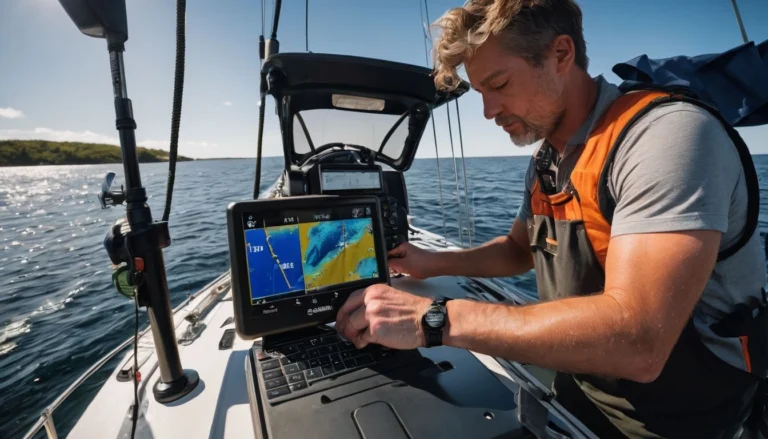What Size Fuse for Garmin Fish Finder?
Choosing the right fuse for your Garmin fish finder can be critical to both performance and safety on the water.
Many boaters are unsure about which size fuse is necessary to protect their valuable electronics from electrical issues.
This article will provide clear guidance on selecting the perfect fuse size for various Garmin fish finder models, ensuring your equipment stays safe while you focus on reeling in your next big catch.
Keep reading for expert tips that will keep you fishing without any interruptions!
Key Takeaways
- Generally, a 3-amp fuse is recommended for Garmin fishfinders to protect against electrical issues and ensure the device operates smoothly.
- It’s essential to match the fuse size with your fish finder model and wire gauge to prevent voltage drops or system failures.
- Use marine-grade batteries like AGM or Gel types for reliable performance and durability; ensure proper wire connections to maintain optimal voltage levels.
- Regularly inspect and replace fuses as needed using the twist-and-pull method, taking care not to damage the fuse housing or connectors.
- Consider installing an in-line fuse close to the battery for additional protection of your Garmin fishfinder’s electrical system.
Understanding Fuse Sizes for Fish Finders
Moving from the basics, let’s delve into the specifics of fuse sizes for fishfinders. Selecting the proper fuse size is crucial because it safeguards your Garmin device against potential electrical issues.
Typically, fishfinders operate on a low-amp draw; hence, a small fuse ranging from 1 to 3 amps usually suffices. But why not just any fuse? The right size ensures your gear stays protected without interrupting power flow.
Accurate selection also helps maintain the optimal performance and longevity of your gadget. For instance, using a very large fuse might not protect effectively against circuit overloads since it won’t blow as intended in the event of excess current.
Conversely, an undersized one can blow too often, leading to unnecessary replacements and possibly missing critical fishing information when you need it most. Always consult related manuals or seek expert advice if you’re unsure about which size fits best for your setup—it’s essential for both safety and functionality on the water.
Importance of the Correct Fuse Size for Garmin Fish Finders
Selecting the right fuse size for your Garmin fishfinder is crucial for both safety and performance. A properly sized fuse acts as a safeguard, protecting your device from electrical surges that can occur in the water.
If a surge happens, the correct fuse will blow first, preventing any damage to the fishfinder’s sensitive electronics. Use of an oversized fuse could fail to protect the equipment adequately during an overload situation.
This oversight might allow too much current to pass through and potentially harm your device or even cause a fire.
Fuses also ensure optimal functionality of your Garmin unit by maintaining a stable power supply. An undersized fuse can blow unnecessarily under normal operating conditions, causing frustration and unexpected interruptions during your fishing trip.
Consistent with users’ reports, using a matching gauge wire with an appropriate inline fuse prevents voltage drops, which are essential for maintaining the full functionality of sophisticated marine electronics like fish finders.
Following these guidelines ensures electrical maintenance doesn’t get in the way of locating those prize catches beneath you.
Recommended Fuse Size for Garmin Fish Finders
Selecting the appropriate fuse size is crucial for protecting your Garmin fishfinder from electrical damage. Continue reading to discover the specific recommendations that ensure optimal performance and safety.
ECHOMAP™ Plus
For the ECHOMAP™ Plus series from Garmin, ensuring you have the right fuse size is crucial. These advanced fishfinders require a consistent power supply to effectively track fish and map underwater structures.
A 3-amp fuse is often recommended to safeguard against potential electrical issues that could damage your device or create hazards on your boat. Installing the correct fuse size helps maintain electrical safety and keeps your fishing expeditions stress-free.
Changing the fuse in these units is straightforward—locate the power cable’s fuse housing and carefully open it using appropriate tools. Once inside, replace any blown fuses with new ones of the same rating to prevent interruptions in device functionality.
Next up is information on another popular model, – STRIKER™ Plus.
STRIKER™ Plus
The STRIKER™ Plus series from Garmin demands a specific fuse size to maintain optimal performance and ensure safety on the water. Users have found that sticking with the 3-amp fuse provided by Garmin is usually best, avoiding any unnecessary complications such as voltage drops or system failures.
Keep in mind to periodically check your electrical connectors for signs of corrosion and apply a thin film of dielectric grease when you open the fuse housing for maintenance or replacement.
This practice will help prevent corroding contacts and maintain a solid connection to your STRIKER™ Plus device.
Replace fuses carefully if needed using a straightforward twist and pull method—this ensures that your fishfinder gets back up and running smoothly. Always secure the spade connector firmly after changing the fuse, and close the fuse housing properly to protect against moisture or debris.
Regular inspection can make all the difference in preventing issues before they arise, letting you focus on fishing rather than fixing equipment.
93SV plus
Shifting our focus to the 93sv Plus, this model also demands attention to its fuse requirements to ensure optimal performance. It’s crucial for users to protect their investment by installing the right-size fuse, as Garmin advises.
A common suggestion within boating forums is to place an in-line fuse close to the battery. This practice aligns with preventing voltage drops and protecting your device from potential electrical mishaps.
For those choosing heavier gauge wires, like a 12-gauge over the standard 18-gauge provided with many models, inserting an appropriate in-line fuse at the battery becomes even more essential.
This not only reinforces boat safety but also keeps connections from corroding. Regular checks and maintenance, including a careful application of lubricant on socket contacts, can help prolong your fisherman’s life while out on the water seeking that perfect catch.
How to Change the Fuse in the Power Cable?
Replacing a fuse in the power cable of your Garmin fish finder is a straightforward task that ensures continuous, optimal performance. With careful attention, you can swiftly change the fuse and safeguard your device against electrical overloads, securing uninterrupted fishing adventures.
Opening the fuse housing
Carefully open the fuse housing on your Garmin fish finder to access the existing fuse. Make sure you have a steady hand and use appropriate tools to avoid damaging any parts. If corrosion is present, it’s crucial to clean it out thoroughly; corroded connections can cause electrical issues and might lead to a need for more frequent fuse replacement.
Once the housing is open, inspect the fuse condition before proceeding with removal using the twist and pull method outlined in our next section. This ensures continuity in the power supply and maintains your device’s performance on the water.
Twist-and-pull methods for fuse removal
Removing a fuse from your Garmin fish finder doesn’t have to be complicated. The twist-and-pull method is straightforward and effective for getting the job done quickly. First, locate the fuse holder on your power cable.
Grasp it firmly with one hand while you gently twist the cap of the holder with the other hand. Once loosened, carefully pull out the cap to reveal the fuse inside.
To remove the fuse from its housing, pinch it between your thumb and index finger and apply a slight twisting motion as you pull upward. This will dislodge it without much force or risk of breaking anything in the process.
Replace it with a new one of identical size and amperage rating to ensure continuous protection for your device against electrical spikes or shorts on board.
Considerations for Different Fuse Types
When selecting a fuse for your Garmin fish finder, it’s crucial to consider the specific types available, as they vary not only in size but also in function and design. Understanding these distinctions ensures that your device is protected effectively, with the appropriate fuse type enhancing both safety and performance.
Blade fuses
Blade fuses are the go-to choice for many boating enthusiasts looking to safeguard their Garmin fishfinders. They slide into fuse holders with ease, making them user-friendly and readily available in various amperages.
Selecting a blade fuse that matches the wire gauge is crucial; it ensures no voltage drop hampers your device’s performance. If your Garmin device requires a 3-amp fuse, opt for a fast-acting blade type to guarantee immediate protection against overcurrents.
For an extra layer of safety, especially with models like the 93SV Plus, installing an in-line blade fuse is wise. This step helps protect upstream wires by using a slightly higher amp rating near the battery terminal.
Trustworthy and efficient, these compact protectors keep you fishing without fear of electrical mishaps jeopardizing your prized gear or catch of the day.
Cylinder fuses
Cylinder fuses, also known as glass or ceramic tube fuses, are a common choice for protecting electronic devices like Garmin fishfinders. They’re designed to break the circuit and cut off electrical flow when excessive current passes through.
Selecting the appropriate fuse is essential for protecting your equipment from potential overcurrent damage because they come in a variety of sizes and ratings. For example, a 3-amp cylinder fuse may be recommended for certain models of Garmin fishfinders to ensure optimal protection without hindering performance.
Installing the correct fuse requires precision; an improperly sized fuse could either blow too easily or fail to protect your device adequately. It’s important to note that people often debate whether additional in-line fusing near the battery is necessary if there’s already one upfront.
However, having that extra layer of protection can be beneficial in preventing damage to both the fishfinder and the boat’s electrical system in case of a short circuit or power surge.
Now let’s look into related queries where specific fuse sizes for popular Garmin models will be discussed further.
Related Queries and Common Fuse Sizes
In the realm of Garmin fish finder maintenance, anglers often find themselves seeking clarity on fuse specifications for various models; a common thread links together questions regarding the striker 4, 93sv, and 106sv units.
Understanding these common fuse sizes not only streamlines installation but also ensures the longevity and reliability of your maritime technology companions.
Garmin Striker 4 fuse size
The Garmin Striker 4 fish finder requires a specific fuse size to safeguard its electrical circuit. For optimal protection, it’s recommended to use a 3-amp fuse, which fits snugly into the yellow fuse housing located at the end of the power wire.
This ensures your device remains secure against any potential overcurrent that could damage the system. If you’re considering running an extended cable from front to back in your boat, as user J791 did, make sure you install a higher-amp fuse near the battery terminal for added security.
Replacing fuses is straightforward with Garmin’s design—simply open up the fuse housing and apply gentle pressure as you twist and pull out the old one. Inserting a new blade-type 3-amp fuse will have your Striker 4 up and running smoothly again.
Remember that using the correct size and type of fuse is essential not only for device safety but also for maintaining consistent performance on all your fishing trips.
Garmin 93SV fuse size
For the Garmin 93sv Plus fish finder, a 3-amp fuse is typically recommended. This size ensures the protection of the device from potential electrical damage without interrupting its normal function.
Users often discuss whether an in-line fuse is necessary for this model; however, ensuring a proper fuse is installed remains critical for safe operation. Installing a higher-amp fuse near the battery terminal can lead to debates among users, but safety and manufacturer recommendations should guide your decision.
Douglasdzaster’s concerns highlight the importance of choosing fast-acting blade fuses carefully to avoid any issues with your Garmin setup. Next up, we’ll look at how you can switch out that all-important little protector in your power cable—changing out fuses doesn’t have to be complicated!
Garmin 106SV fuse size
Selecting the proper fuse size for your Garmin 106SV fishfinder is vital to ensuring both safety and optimal performance. To prevent any electrical issues, it is crucial to match the fuse’s amperage with the manufacturer’s specifications.
For a Garmin fishfinder 106sv, users often query whether they should utilize the included 3-amp fuse or opt for something more substantial.
Most people agree that the 3-amp inline fuse that was provided is the best way to protect and work properly. However, it is important to make sure that it fits the wire gauge to avoid voltage drops and keep upstream wires safe.
Changing fuses can be straightforward if approached correctly. Use blade fuses that are fast-acting to guarantee swift reaction times during power surges, thus protecting your device.
This proactive measure avoids potential complications down the line with your Garmin unit. After securing your Garmin 106sv with an adequate fuse, it’s time to focus on battery considerations when installing and using a fish finder for uninterrupted marine adventures.
Battery Considerations When Using Garmin Fish Finders
Ensure your Garmin fishfinder operates at its best by connecting it to a reliable battery source. The device’s performance directly relates to the power supply’s stability and endurance, making it crucial to use a marine-grade battery with adequate capacity for your trips on the water.
Selecting a high-quality AGM or Gel battery can significantly improve the efficiency of your fishfinder, as these types are known for their durability and ability to hold charge over extended periods.
They handle repeated charging cycles well, ensuring that power problems won’t catch you off guard when searching for those elusive fish.
Maintaining an optimal voltage level is essential for the proper functioning of sensitive electronics like your Garmin fish finder. Excessive voltage drop due to inadequate wire gauge or poor connections can lead to inaccurate readings and potential harm to the device.
To prevent such scenarios, users suggest using fuses matched with wire gauge size; this precaution safeguards both the gadget and wiring from current spikes or short circuits. Opt for marine-grade wiring and connectors resistant to corrosion, typically found in harsh aquatic environments where Garmin devices are used extensively.
Tailored care in battery selection and fuse integration goes a long way toward maximizing enjoyment and success during fishing expeditions.
Conclusion
Securing your Garmin fish finder with the proper fuse size is a small but critical step towards optimal performance and safety. Tailoring the fuse to your model protects both the device and your boat’s electrical system from potential harm.
Always stand by manufacturer recommendations, and remember that precision in these details makes for smoother sailing and better catches on all your fishing adventures. Reach out for professional advice if you’re unsure, as this simple choice can make a big difference in functionality.
Keep an eye on those fuses, because when they fit just right, you’ll be set for many successful trips on the water!
FAQs on Garmin Fish Finder Fuse Size
Gary Burrell
Born in 1989, Gary Burrell is an Electrical Engineering graduate from the University of Tennessee. With 20+ years of experience, he has transitioned from engineering roles to becoming the Chief Content Editor. Gary’s unique blend of technical knowledge and editorial expertise has made him an essential figure in content creation, ensuring clarity and accuracy. His journey from an engineer to an editor showcases his adaptability and commitment to continuous learning.




